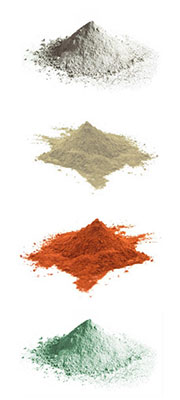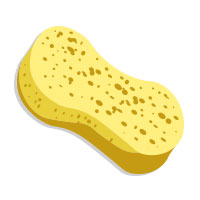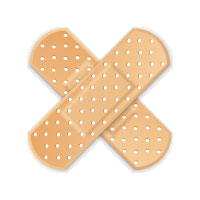The clay
important fact about clays

About clays
Clay is not just clay, there are various different sorts.
All types come from the transformation of metamorphous or eruptive parents rocks such as : granite, gneiss, trachyte.
The following is encountered :
- Transformed clay in situ, that is to say the parent rock has been turned into clay over thousands of years.
In this type of formation, the transformation is rarely complete, and often the presence of loose silicia, which can be inconvenient due to its abrasiveness, can be noted. This implies that if we treat by cleaning and spin separation, pratically all Kaolins undergo the treatment. - Sedimentary types of clay which are formed by the erosion of older clay which is then washed away by water. The lightest parts are carried further than the heavier, and this causes a sort of natural purification, meaning that sedimentary clay is much less contaminated by silicia.
Properties
First of all, it is important to highlight that it is uncommon to find an absolutely pure variety of clay in nature and that we often find a mix of two or more varieties, which offers the characteristics of each of them.
Before starting, the 3 main clay properties are as follows:

Absorption
Absorption is a physic and chemical phenomenon in which molecules are hold in-depth. For clays, this property consists in the absorption of toxins as does a sponge with water.

Adsorption
Adsorption is, according to chemistry, a surface phenomenon which consists in biding atoms and molecules. In the same way as magnets, it is an essential property for clays (called CEC or Cationic Exchange Capacity…), allowing them to bind molecules and gas.

Covering power
Covering power is a physical phenomenon that comes straight from the inherent structure of clays. Clay particles stick to each other covering surfaces. This property shows the clay capacity to act as a dressing.
Regarding the use of clays, we can easily give their main properties:
- Kaolinites : High covering power and chemical inertia. For example, 1g of Kaolin would be enough to cover a tennis ground if we spread apart all its particles…
Main uses : inert fillers for papermaking, pharmacy, porcelain and industry in general. - Palygorskite (or attapulgite), sepiolite : because of their fibrous structure, they offer a high absorbing power. Adsorbent power is low and suspensions in water show a good viscosity by mechanical effect (instead of chemical as it is the case with smectite), allowing for suspensions in highly ionised environments.
Main uses : animal beddings, floor absorbents and offshore drilling, mud in saturated salted condition. - Illites : the covering power is average, absorbent and adsorbent powers are average too. These clays are very « plastic » and as they offer little or no swelling, they have a low drying shrinkage.
Main uses : for the making of products like ceramic, bricks, tiles, etc…. - Montmorillonite, beidellite : These clays are characterized by a high adsorbent and covering power and a low absorbent power. The interlayer ionic non saturation allows a variation of distances between layers, as well as the possibility of ions binding’s changing. This is the cationic exchange capacity (C.E.C.) that allows these clays either to be active to increase their characteristics (bentonite and acid clay), or to neutralize big organic molecules like toxins, alkaloids, etc, by means of covalent bond, when they are used naturally.
Main uses : Natural Smectites are mainly used in pharmacy, dietetic and cosmetic. Active Smectites are mainly used in wine clarification, decolourisation of oils, oil drilling mud or public works mud binders for foundry moulds.
Note that these four big types are divided in subtypes with specific properties.
Mineralogy
Clay is always a simple or complex silicate of aluminium, magnesium and iron. Irrespective of the type it can be differently coloured.
In fact the colouring is due to the presence either of ferrous or ferric iron, or of other contaminants, albeit in very small quantities, which in no way affect the physico-chemical properties of the clay.
There are four big families :
DOUBLE LAYERS : KAOLINITES OR HALLOYSITES
In this class electronic microscope show “plate stacks” for the kaolin. In the case of the Haloycite these same plates rolled up like a jam roll lend a fibric appearance.
PSEUDO-LAYERS ( FIBRIC CLAY ), ATTAPULGITES, SEPIOLITES
Analysis by electronic microscope shows interwining of fibres with the following sizes : 2 to 5 µm ( µm = one millionth of a metre ) for attapulgite and 5 to 10 µm for sepiolites.
TRIPLES LAYERS, COMPRISING TWO FAMILIES
Glauconites illites ( non gonflant because of the fixed inter reticular space ).
Smectites ( montmorillonites/bentonites and beidellites ) which can be gonflant because the space between the layers is variable.
Looking at these two families under the electronic microscope one sees many rough layers.
Different types of clay cannot be identified precisely by classical chemical analysis. In fact, two sorts of clay can have the same type of chemical analysis whilst being in themselves completely different ( for example attapulgites and montmorillonites or bentonites in the same quarry at different heights in the stratigraphy can have exactly the same chemical analysis ).
The only precise way of identifying them is therefore X diffraction which in measuring the space between two layers lets us classify the mineral with confidence.
